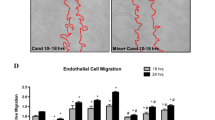Abstract
We have shown that reduction of blood pressure (BP) immediately after the onset of reperfusion reduced neurovascular damage and improved functional outcome after experimental cerebral ischemia and candesartan is particularly effective in improving long-term functional outcome. In this study, we sought to determine if early BP lowering with candesartan, in the presence of an occluded cerebral artery, will reduce injury and improve outcome after experimental stroke. Male Wistar rats underwent 24 h or 7 days of middle cerebral artery occlusion (MCAO). A single dose of 1 mg/kg candesartan was administered intravenously at 3 h after MCAO. Animals received neurobehavioral testing at 3 h, 24 h, and 7 days, and blood pressure was measured by telemetry. Animals had brain tissue collected for infarct size (24 h and 7 days), hemoglobin content, matrix metalloproteinase (MMP) activity, and vascular endothelial growth factor (VEGF) expression (24 h only). Candesartan significantly decreased blood pressure, infarct size (−20%; p = 0.021), hemoglobin excess (−50%; p = 0.0013), and edema (−35%; p = 0.0005) at 24 h after MCAO. This resulted in a reduced cerebral perfusion deficit (p = 0.034) in the ischemic hemisphere compared with saline and significantly improved Bederson scores and paw grasp. MMP-2, MMP-9, and VEGF were significantly increased by MCAO, but there were no differences between candesartan- and saline-treated animals. There were no significant differences in behavioral outcome at day 7. BP lowering with candesartan reduces early brain injury after experimental stroke even when the artery remains occluded. The early benefits were not sustained at 7 days, as seen in reperfused animals, however. The neuroprotection and neurorestorative properties of candesartan may occur by separate distinct mechanisms.






Similar content being viewed by others
References
Sare GM, Geeganage C, Bath PM. High blood pressure in acute ischaemic stroke—broadening therapeutic horizons. Cerebrovasc Dis. 2009;27 Suppl 1:156–61.
Sare GM, Ali M, Shuaib A, Bath PM, VISTA Collaboration. Relationship between hyperacute blood pressure and outcome after ischemic stroke: data from the VISTA collaboration. Stroke. 2009;40:2098–103.
Kozak W, Kozak A, Johnson MH, Elewa HF, Fagan SC. Vascular protection with candesartan after experimental acute stroke in hypertensive rats: a dose–response study. J Pharmacol Exp Ther. 2008;326:773–82.
Elewa HF, Kozak A, Johnson MH, Ergul A, Fagan SC. Blood pressure lowering after experimental cerebral ischemia provides neurovascular protection. J Hypertens. 2007;25:855–9.
Fagan SC, Kozak A, Hill WD, Pollock DM, Xu L, Johnson MH, et al. Hypertension after experimental cerebral ischemia: candesartan provides neurovascular protection. J Hypertens. 2006;24:535–9.
Kozak A, Ergul A, El-Remessy AB, Johnson MH, Machado LS, Elewa HF, et al. Candesartan augments ischemia-induced proangiogenic state and results in sustained improvement after stroke. Stroke. 2009;40:1870–6.
Engelhorn T, Goerike S, Doerfler A, Okorn C, Forsting M, Heusch G, et al. The angiotensin II type 1-receptor blocker candesartan increases cerebral blood flow, reduces infarct size, and improves neurologic outcome after transient cerebral ischemia in rats. J Cereb Blood Flow Metab. 2004;24:467–74.
Saqqur M, Tsivgoulis G, Molina CA, Demchuk AM, Siddiqui M, Alvarez-Sabín J, et al. CLOTBUST Investigators. Symptomatic intracerebral hemorrhage and recanalization after IV rt-PA: a multicenter study. Neurology. 2008;71:1304–12.
Zea Longa E, Weinstein PR, Carlson S, Cummins R. Reversible middle cerebral artery occlusion without craniectomy. Stroke. 1989;20:84–91.
Hilali HM, Simpkins AN, Hill WD, Waller JL, Knight RA, Fagan SC. Single slice method for quantification of hemorrhagic transformation using Direct ELISA. Neurol Res. 2004;26:93–8.
Bederson JB, Pitts LH, Germano SM, Nishimura MC, Davis RL, Bartkowski HM. Evaluation of 2,3,5-triphenyltetrazolium chloride as a stain for detection and quantification of experimental cerebral infarction in rats. Stroke. 1986;17:1304–8.
Machado LS, Kozak A, Ergul A, Hess DC, Borlongan CV, Fagan SC. Delayed minocycline inhibits ischemia-activated matrix metalloproteinases 2 and 9 after experimental stroke. BMC Neurosci. 2006;7:56–62.
Abdelsaid MA, Pillai BA, Matragoon S, Prakash R, Al-Shabrawey M, El-Remessy AB. Early intervention of tyrosine nitration prevents vaso-obliteration and neovascularization in ischemic retinopathy. J Pharmacol Exp Ther. 2010;332:125–34.
Borlongan CV, Sanberg PR. Elevated body swing test: a new behavioral parameter for rats with 6-hydroxydopamine-induced hemiparkinsonism. J Neurosci. 1995;15:5372–8.
Bederson JB, Pitts LH, Tsuji M, Nishimura MC, Davis RL, Bartkowski H. Rat middle cerebral artery occlusion: evaluation of the model and development of a neurologic examination. Stroke. 1986;17:472–6.
Meyer JS, Shimazu K, Fukuuchi Y, Ohuchi T, Okamoto S, Koto A, et al. Impaired neurogenic cerebrovascular control and dysautoregulation after stroke. Stroke. 1973;14:169–86.
Guo S, Kim WJ, Lok J, Lee SR, Besancon E, Luo BH, et al. Neuroprotection via matrix–trophic coupling between cerebral endothelial cells and neurons. PNAS. 2008;105(21):7582–7.
Hamai M, Iwai M, Ide A, Tomochika H, Tomono Y, Mogi M, et al. Comparison of inhibitory action of candesartan and enalapril on brain ischemia through inhibition of oxidative stress. Neuropharmacology. 2006;51:822–8.
El-Remessy AB, Al-Shabrawey M, Platt DH, Bartoli M, Behzadian MA, Ghaly N, et al. Peroxynitrite mediates VEGF’s angiogenic signal and function via a nitration-independent mechanism in endothelial cells. FASEB J. 2007;21:2528–39.
Reeves MJ, Arora S, Broderick JP, Frankel M, Heinrich JP, Hickenbottom S, et al. Acute stroke care in the US: results from 4 pilot prototypes of the Paul Coverdell National Acute Stroke Registry. Stroke. 2005;36:1232–40.
Schrader J, Luders S, Kulschewski A, Berger J, Zidek W, Treib J, et al. The ACCESS study: evaluation of acute candesartan cilexitil therapy in stroke survivors. Stroke. 2003;34:1699–703.
Sources of funding
This work was supported by VA Merit Review and RO1 NS063965 to SCF, and AHA and JDRF to ABE.
Disclosure
SCF has been a consultant or participated in a Speaker Bureau for Pfizer and Ferrer.
Conflict of interest
None.
Author information
Authors and Affiliations
Corresponding author
Rights and permissions
About this article
Cite this article
Guan, W., Kozak, A., El-Remessy, A.B. et al. Acute Treatment with Candesartan Reduces Early Injury After Permanent Middle Cerebral Artery Occlusion. Transl. Stroke Res. 2, 179–185 (2011). https://doi.org/10.1007/s12975-010-0061-1
Received:
Revised:
Accepted:
Published:
Issue Date:
DOI: https://doi.org/10.1007/s12975-010-0061-1




